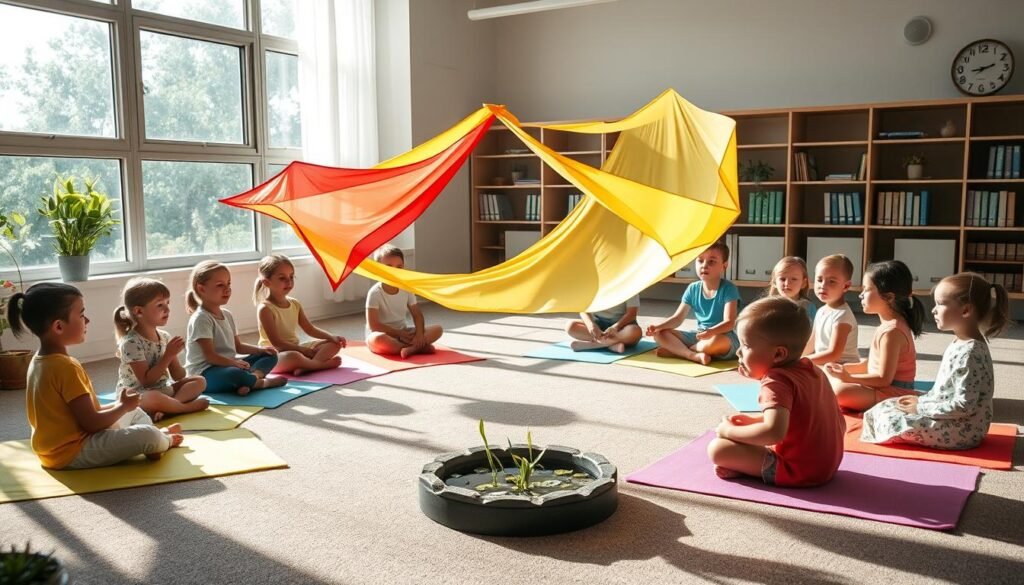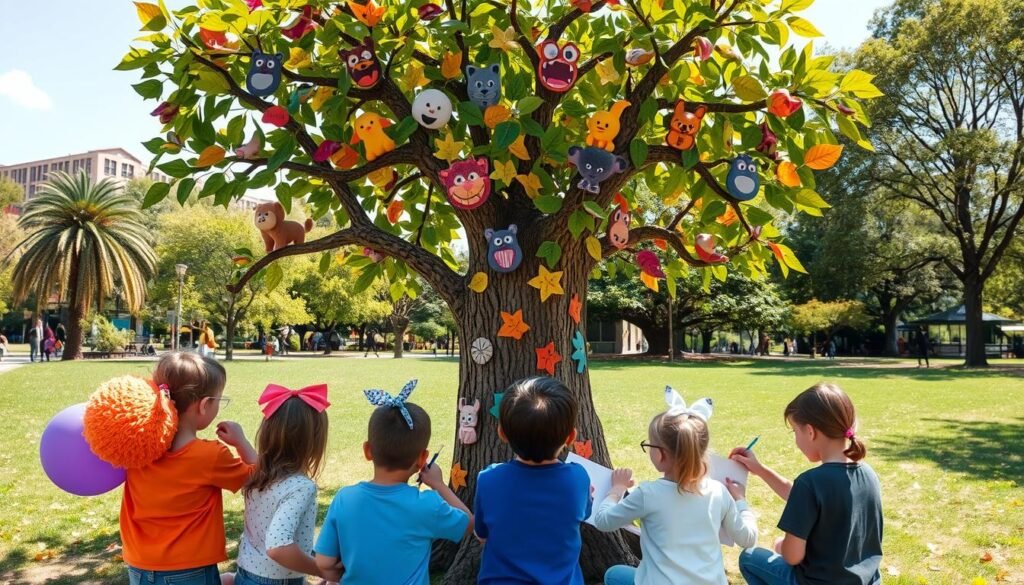Almost one-third of teens in the U.S. are dealing with anxiety disorders. This makes it a big issue for families nationwide. With anxiety on the rise, partly because of COVID-19, parents are key to their kids’ mental health. They need to understand childhood anxiety well. This helps them support their children better during these tough times. Recognizing anxiety’s signs, knowing its causes, and using good parenting tactics are vital. These steps help improve children’s emotional well-being and resilience. This guide shows parents how to help their kids handle anxiety and feel more in control.
Key Takeaways
- Almost 32% of U.S. adolescents are reported to have an anxiety disorder.
- Parents play a crucial role in helping children recognize and cope with anxiety.
- Effective parenting strategies are essential for emotional health in children.
- Early intervention can significantly improve a child’s ability to manage anxiety.
- Recognizing symptoms of anxiety is the first step in helping children regain control.
- Open communication between parents and children promotes resilience.
Understanding Childhood Anxiety Disorders
Childhood anxiety disorders include a range of mental health challenges. Children as young as four can be affected. These issues cover generalized anxiety disorder (GAD), social anxiety, and separation anxiety, to name a few. Recognizing these types of anxiety disorders is crucial for early help. Kids often show anxiety through fear, nervousness, and physical signs like headaches.
It’s important to understand anxiety in kids. Their signs can vary, showing as constant worry over daily activities. This can create obstacles in their social and school lives. For instance, social anxiety might make a child avoid school or friends. Separation anxiety can make being away from parents really hard.
Parents have a key role in tackling these problems. They should get help if they see signs of anxiety in their child. Acting early is very important. It can make a big difference in the child’s life. A good resource is the Wellness Road Psychology website. It offers help on dealing with childhood anxiety.
Learning about anxiety helps parents a lot. Cognitive behavioral therapy (CBT) is a common treatment. It helps kids face their fears and learn to cope. Sometimes, therapy might include medication for more severe anxiety.
- Generalized Anxiety Disorder (GAD): Persistent worries about multiple aspects of life.
- Social Anxiety Disorder: Fear of social situations leading to avoidance behaviors.
- Separation Anxiety Disorder: Intense fear of being away from a caregiver.
- Panic Disorder: Overwhelming physical symptoms, often seen more in teens.
- Selective Mutism: Inability to speak in specific situations due to fear.
- Specific Phobias: Intense fear of specific objects or situations.
Parents need to watch closely and act early. Seeking help is the first step to understanding childhood anxiety disorders. This action sets the stage for kids to learn better coping mechanisms.
Recognizing Symptoms of Anxiety in Children and Teens
It’s important to know the signs of anxiety in kids and teens. About 1 in 5 children may face an anxiety disorder. This shows how common it is. Knowing what to look for helps parents act early.
Young kids might throw tantrums, wet the bed, or not sleep well. They often say they have stomach or head pains. These can be hidden signs of how they’re feeling inside. Look for signs like:
- Worrying too much about many things
- Having a hard time getting to sleep or staying asleep
- Feeling tired a lot
- Having trouble focusing
- Being scared or worried often
As kids become teenagers, spotting anxiety gets harder. Teens may keep their feelings secret. They might get moody, avoid friends, or not want to go out. Look out for these signs:
- Doing poorly in school
- Skipping social activities
- Using drugs or alcohol
- Eating more or less than usual
Studies show that if a parent has anxiety, their kids might too. Anxiety can get worse from tough experiences or strict rules at home. Sometimes, you won’t see the signs until something big changes, like a new school.
Parents should look out for both physical and emotional signs of anxiety. It’s key to get help when needed.
| Age Group | Common Symptoms |
|---|---|
| Children (0-12) | Tantrums, sleep problems, tummy aches, negative thoughts, bedwetting |
| Teens (13-19) | Irritability, withdrawal, academic decline, social anxiety, substance use |
Exploring the Causes of Anxiety in Kids
Anxiety in kids comes from different places, including their surroundings and their genes. Research shows it can run in families. Kids with parents who have anxiety are more likely to struggle with it too. About 23% of children from some studies have high anxiety levels.
What happens around kids can make them feel anxious. Stressful events like family issues, being bullied, or dealing with trauma are big triggers. Families facing a lot of stress see more anxiety in both adults and children. But, positive parenting can help. Being supportive can protect kids from anxiety, even when times are tough.
Biological factors also play a role in kids’ anxiety. Sometimes, how parents act, like being too protective or not supportive, can raise a child’s anxiety. If kids feel they have no control over what happens to them, it can lead to more anxiety down the road. Parents should help kids see themselves in a positive light. This builds resilience against anxiety triggers.
Understanding why kids feel anxious means looking at both environmental and biological reasons. When parents understand these factors, they can help their kids better. This means creating a supportive environment that helps them handle their anxiety.
The Role of Parents in Helping Children Manage Anxiety
Parents play a key role in helping their kids deal with anxiety. It’s important to step in early. This helps prevent anxiety from getting worse, and teaches kids how to cope. Talking openly about feelings makes kids’ emotions feel valid. It shows parents are there to support. Showing how to deal with emotions in a healthy way can also help stabilize kids’ feelings.
Importance of Early Intervention
Dealing with anxiety early can really change a child’s mental health outlook. Parents can create routines. This makes kids feel stable. Such practices reduce uncertainty, boosting a child’s overall well-being.
How Parental Behavior Influences Anxiety
How parents act greatly affects how their kids grow emotionally. Being too protective can stop kids from learning resilience, leading to anxiety. Seeing anxious behaviors in parents can lead kids to act the same way. Always criticizing and setting high expectations can make kids feel never good enough, increasing anxiety.
- Open talk encourages sharing feelings instead of hiding them.
- Unclear rules from parents can leave kids confused, raising anxiety levels.
- Controlling every choice stops kids from learning to make decisions, important for emotional development.
- A healthy lifestyle with good food, enough sleep, and exercise improves mood.
| Parental Behavior | Effect on Child Anxiety |
|---|---|
| Overprotection | Hinders coping abilities |
| High Expectations | Creates performance anxiety |
| Lack of Emotional Expression | Leads to emotional suppression |
| Inconsistent Parenting | Causes confusion and anxiety |
| Micromanagement | Stifles autonomy and independence |
Creating a space where kids can talk and express themselves is crucial. Parents taking care of themselves show that handling anxiety is about support and care. Knowing how parents help with anxiety helps build a child’s ability to face life’s problems.
Effective Parenting Strategies for Managing Anxiety
Effective parenting is key in helping children deal with anxiety. By keeping communication open, parents lay a strong foundation. This support allows kids to share their feelings. It builds their confidence and resilience in tackling anxiety.
Maintaining Open Lines of Communication
It’s important to talk to children about their worries. Communication with children should be easy and open. By asking open-ended questions, parents can learn more about what their kids feel. Talking about what scares them helps kids to confront their fears, not avoid them. They know they can share their feelings without being judged. This kind of support is crucial.
Building a Supportive Environment
A supportive environment means recognizing kids’ efforts to face their fears. Parents shouldn’t be overprotective as it may worsen anxiety. Instead, encourage fun activities, daily exercise, and a set routine to help lower stress. Praising bravery, especially in school, boosts their courage.
Maintain healthy habits like good sleep and proper meals for coping with stress. These habits help children manage their anxiety better.
Developing Coping Mechanisms for Children
Teaching kids to handle anxiety is key. Techniques like deep breathing help calm anxious feelings. Parents play a crucial role in showing these strategies. They give kids the tools to tackle their fears.
Deep Breathing Techniques
Deep breathing is a great way to calm down. It helps the body relax. Parents can teach this by showing how to take a big breath through the nose, hold it, then exhale slowly through the mouth. Adding things like cue cards or calming jars can make this more effective. Kids like having something they can see to help with their breathing.
Positive Self-Talk Strategies
Positive self-talk helps kids change their mindset and build emotional strength. Teaching kids to swap negative thoughts for positive ones is beneficial. For example, they can learn to say, “I can handle this,” instead of focusing on fears. Parents should use positive self-talk too. Doing this together helps family support each other while learning helpful coping skills. For more tips, check out resources on managing children’s anxiety.

Utilizing Cognitive-Behavioral Techniques
Teaching kids cognitive-behavioral techniques helps them handle anxiety. They learn to spot and change negative thoughts. This shift can lessen their anxiety and lead to a healthier mindset over time.
Reframing Negative Thoughts
Many kids get stuck in negative thinking that makes their fears worse. By learning to change these thoughts, they can view things more positively. For example, changing from “I’ll fail this test” to “I’ll prepare and do my best” builds optimism and control.
Shifting thoughts is a key part of cognitive-behavioral methods. It’s vital for growing resilience.
Gradual Exposure to Fear-Inducing Situations
Slowly facing fears is a core cognitive-behavioral strategy. It lets kids tackle their fears bit by bit in a safe way. Starting with small steps builds confidence and reduces anxiety.
For instance, a child scared of dogs might first watch dog videos. Then, they could look at dogs from afar, and later pet a calm dog. Each step is an achievement that lessens their fear.
Engaging in Mindfulness Exercises
Adding mindfulness exercises to daily life can really help kids with anxiety. Techniques like mindful breathing are great for focusing on the now. They reduce stress and help kids and parents feel better emotionally. Doing these activities together can make family ties stronger. It also helps kids learn to control their emotions better.
Mindful Breathing Techniques
Mindful breathing is simple but very effective for calming down and staying steady. By teaching kids to breathe deeply and slowly, parents can help them handle their feelings better. About 64.2% of people think mindfulness helps with parenting. And 56.4% want to learn it to help their kids feel better. This shows how important mindful breathing is for dealing with anxiety.
Being patient and regular with these exercises is key because kids might take a while to get them right. Here are some fun breathing activities for kids:
| Activity | Description |
|---|---|
| Bubble Breathing | Imagining blowing bubbles while exhaling, promoting calmness and focus. |
| Flower and Candle | Inhaling deeply as if smelling a flower, then exhaling gently as if blowing out a candle. |
| Counted Breaths | Counting each breath to build awareness and provide a sense of rhythm. |
| Animal Breathing | Imitating animal breathing patterns to make it fun and engaging for children. |
Doing mindfulness exercises together can make a family’s life more peaceful. It often means fewer fights and better talking with each other. Parents looking for more on these techniques can check out this site. It has a lot of info on mindfulness exercises to improve life for both parents and kids.

The Power of Positive Reinforcement
Positive reinforcement is key to helping kids beat their fears. By praising their efforts, parents can push their kids to face tough tasks. This builds resilience and confidence. Every step forward is celebrated, making a strong base for emotional growth.
Praising Efforts and Resilience
Regular positive feedback is crucial for a child’s mental health. Celebrating their efforts motivates kids to keep reaching for their goals. It helps them handle anxiety and feel good about themselves. Parents should focus on the effort, not just natural talent. This approach boosts resilience, getting kids ready for future hurdles.
Setting Realistic Goals
It’s important to set achievable goals for kids dealing with anxiety. Parents need to outline goals that kids can actually reach. This shows them that they can overcome challenges. Breaking big tasks into smaller steps helps, too. This method builds confidence. Having kids involved in goal-setting also empowers them, showing that their hard work pays off.
Building Emotional Intelligence in Kids
Emotional intelligence is key in helping kids manage feelings and build healthy relationships. Parents play a big role in teaching kids to understand and express their emotions clearly. This not only helps with anxiety but also improves their emotional health.
Teaching Empathy and Understanding Emotions
Empathy is central to emotional intelligence. It helps kids understand others’ feelings, leading to stronger friendships and social skills. Parents can teach empathy by:
- Modeling empathetic behavior in daily life.
- Talking about emotions while reading stories or watching movies.
- Discussing how others might feel in different situations.
Highlighting empathy lets kids better handle their emotions and connect with others positively.
Encouraging Healthy Expression of Feelings
It’s important for kids to share their feelings in a productive way. Open talks about feelings help them express themselves clearly. Ways to encourage this include:
- Having kids talk about their feelings.
- Creating safe spaces for emotional expression through art, play, or talking.
- Reading books about feelings together, which helps discuss emotional experiences.
These methods boost emotional intelligence and strengthen bonds between parents and kids. They lay the groundwork for coping well with tough times.

| Benefits of Emotional Intelligence | Impact on Children |
|---|---|
| Improved Academic Success | High emotional intelligence leads to better grades, thanks to improved focus and stress handling. |
| Reduced Mental Health Issues | Good emotional management reduces the chance of anxiety and depression. |
| Increased Resilience | Kids with strong emotional intelligence recover from setbacks more positively. |
| Enhanced Social Relationships | These kids form stronger friendships and are better at dealing with social situations. |
Creating a Family Support System
A strong family support system is key in helping children with anxiety. It makes them feel secure and lets them share feelings. Talking about worries and emotions builds trust. Everyone feels they matter and are understood.
Encouraging Open Family Discussions
Open communication within the family is vital. Kids should be able to talk about their fears freely. Conversations can happen during family meetings or meals. This lets kids share their thoughts, and parents can help. Parents might also suggest ways to cope, like using community support for anxiety.
Participating in Family Activities Together
Doing things as a family strengthens bonds and fosters belonging. Activities like game nights or outdoor fun unite everyone. They help lessen anxiety and create happy memories. These good times show that family is a safe place when things get tough.
Conclusion
Helping kids deal with anxiety is key to their mental health. Around 32% of kids in the U.S. face it. It’s important to tackle disorders like generalized anxiety early. Parents play a big role here. They can make a safe space and show they understand their kids’ feelings. This helps kids handle their worries better.
Parents can help by talking openly, teaching ways to cope, and being realistic. It’s also important for parents to look after their own mental health. A strong bond between parent and child reduces problems. So, building strong relationships is vital for a child’s ability to bounce back.
By following these steps, parents can lower childhood anxiety. This not only helps their children but also makes the future brighter. It avoids issues like bad grades and trouble making friends. With informed and proactive parents, families can foster better emotional growth. Ultimately, this leads to lasting social improvement.